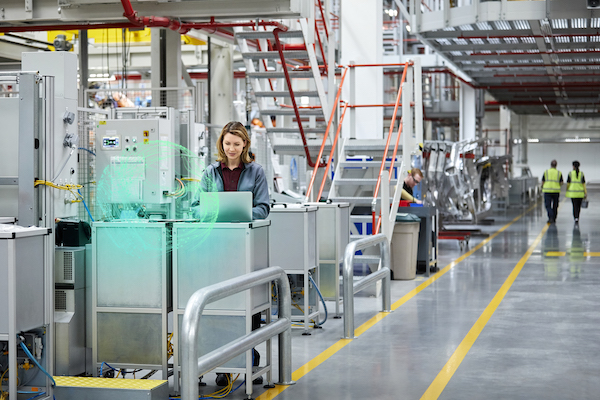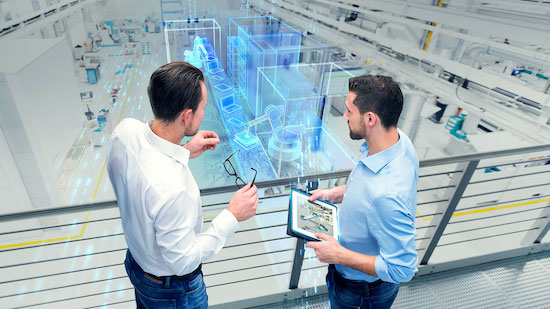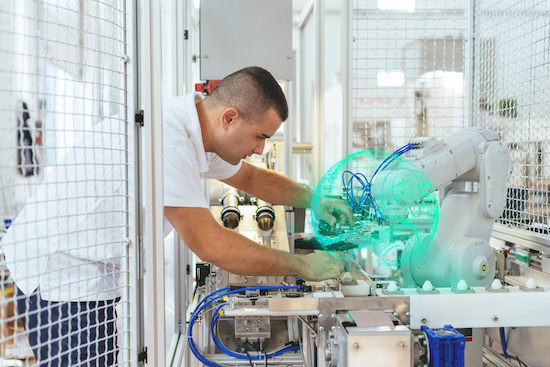
Figure 1: Tomorrow we can look forward to a future of smart, connected products as innovation accelerates across industries. Images courtesy of Siemens Digital Industries Software.
Latest News
March 15, 2022
The future of industry, broadly speaking, is bright. We are experiencing an extremely exciting time as innovation accelerates across every major industry, from automotive, aerospace, and marine, to consumer products and electronics (figure 1). The result is widespread improvements in product performance, the creation of advanced features and functionality, and growing product intelligence. It seems we can look forward to a future of intelligent, connected products that offer greater value than ever to our lives, both professionally and personally.
And yet, exciting times are also often challenging times. As we emerge from a global pandemic, companies are reckoning with new modes of work and collaboration, while also learning how to deal with broken supply chains. Plus, innovation introduces its own challenges. Smarter products increase the complexity of product design, manufacturing, and service, which is being compounded further by demands for greater personalization and customization options in products. While companies seek to support the demands of the modern marketplace, they must also develop comprehensive sustainability approaches that encompass global supply chains, product development, manufacturing processes, and end-of-life.
Clearly, we have some mountains to climb on our path to the future. There is, however, much reason for optimism. A digital revolution is taking shape that will help companies become more innovative, sustainable, resilient, and, yes, even more profitable than before. Enterprise-level digitalization and the creation of a comprehensive digital twin will make climbing those impending mountains a whole lot easier, connecting teams and ideas, accelerating the development of advanced products, and enabling greater levels of efficiency and productivity throughout the lifecycle. Digitalization, or digital transformation, is all about creating digital threads between siloed or disparate areas of data and functionality. It is precisely at these intersections that the greatest opportunity for innovation lies to achieve greater performance, sustainability and efficiency.
Realizing the Digital Future
I’d like to briefly step through each stage of product development to illustrate how digital transformation can help companies in all industries reach their goals. First, it’s important to recognize the role of model-based systems engineering (MBSE) in enabling such a comprehensive, digitized approach. Model-Based Systems Engineering (MBSE) is the starting point for today’s innovative and smart products. As products and programs grow in complexity, next-generation MBSE tools enable seamless interoperability of models through product development and across its lifecycle. MBSE connects all the sources of data and experts to create a comprehensive digital twin of the product, and harnesses the digital enterprise to weave together engineering, manufacturing and even outside suppliers to add value at every step of development.
Now, each domain needed to create a complex product can effortlessly stay in sync while meeting their specific goals. When concepting for a new product, system architects using MBSE can access models from previous product iterations, quickly and confidently derive new features, and ideate fresh designs. The resulting product architecture leads to the creation of a digital twin that will eventually encompass every aspect of the product. Next, an MBSE solution provides the different product engineering disciplines—electrical, mechanical, software and interconnect—the flexibility to define and optimize their systems while cooperatively developing the interfaces between them. This single source of truth of the digital twin enables earlier and continuous verification and validation of the overarching product architecture even as the design moves into manufacturing and eventually into the real world. MBSE gives teams a path to create tomorrow’s innovative and smart products on aggressive schedules while ensuring the highest quality.
Ultimately, the aim is to connect all these digital assets to the product in the field, enabling a comprehensive digital twin that offers an ‘as performs’ virtual representation of the product. These connections known as digital threads span the product lifecycle, from definitions through to in-field performance, ensuring that data regarding the product, its attributes, performance, or functionality in the field can be traced to how it was defined, designed, manufactured, and supported over its lifetime. The business case for investing in such a digital twin comes down to data and digital threads: a strong flow of data from initial definition and concept stages through to the product in the field will enable faster product innovation through enhanced cross-domain collaboration, fewer errors that contribute to development cost, and a wealth of information and insights from real-world product usage data. In short, it will help a company to become more efficient with its resources, more informed when making decisions, and more agile when responding to dynamic market demands. Now, lets see how this is taking shape today.
Definitions and Product Design
The digitalization of product definition and design involves the capturing of requirements, goals, and concepts for the product in a digital format that is traceable and manageable. Such a format provides a ‘single source of truth’ that will guide not only the product design, but also verification and validation programs, manufacturing design, materials selection and much more. Indeed, as we move into the age of smart, complex, and sustainable products requirements are more numerous and more varied than ever.
Take, for example, the autonomous vehicle (AV). Even a lower-level AV – whether a passenger car, an aircraft, or an automated guided vehicle (AGV) – comes with a slew of requirements around safety, compute resources, connectivity both internally and to external systems, thermal management, energy consumption and more. Then, design and engineering teams must find ways to bring all these requirements together in a vehicle that is nearly flawless in operation, often with advanced features and functionality, and a high-quality user experience.
A comprehensive digital twin is perfectly suited to the demands of tomorrow’s advanced products (figure 2). Product requirements are captured in an intelligent, digital format that follows the product throughout its entire lifecycle. Meanwhile, integrated engineering software enables cross-domain collaboration, early design verification and validation through simulation, and the ability to more rapidly evaluate and select the best of numerous design alternatives. Rather than operating in silos, design teams will be able to collaborate to find the best solutions, resulting in advanced and exciting products. Underneath it all, MBSE tracks design iterations, functional models, test results and more, tying them back to the initial product definitions and requirements.

Manufacturing Tomorrow
As we move into the production phase of modern product development, there are more challenges and more opportunities. Complex products often require complex manufacturing processes, increasing the cost and time of production. The push for product individualization increases complexity further, as manufacturers must devise increasingly flexible and autonomous production systems to meet demand. And manufacturers are also determining how to do all this while using fewer resources, less energy, and more sustainable materials. Each challenge also presents an opportunity, where new technologies and new methodologies can help companies create efficient, flexible, and reliable production systems (figure 3).
One such technology is additive manufacturing (AM). AM is faster and more flexible than traditional manufacturing methods, such as injection molding, because it removes many of the constraints imposed by these traditional methods. The flexibility of AM makes it a potential boon for manufacturers hoping to create highly personalized products for their customers, while the relative lack of manufacturing constraints allows engineers to reimagine product designs to integrate new technologies or design philosophies. For example, AM can print complex lattice structures that maintain structural rigidity while also improving thermal performance and reducing the weight of the product or part. This means that manufacturers can produce higher performing products and better serve their customers while also reducing the waste created during subtractive production.

Figure 3: The challenges of manufacturing modern complex products are being overcome through new technologies and manufacturing methodologies.
Digitalization, again, is key to adopting AM and other advanced manufacturing technologies, such as automated logistics systems and the industrial internet of things (IIoT). For AM, a tightly integrated digital twin is critical to achieving quality products while minimizing design iterations. Before printing, designs must undergo rigorous simulations of the printing process to mitigate risks, optimize the printing and, thus, improve yield. At the facility level, the digitalization of production lines enables machine monitoring, predictive maintenance, and the analysis of entire production processes to optimize material delivery, line balancing, and more.
The digitalization of supply chain management plays a role here as well. The global pandemic has exposed some cracks in how supply chains are constructed and managed today. Fortunately, digitalization can help us take advantage of this situation, opening the doors to communication and collaboration between OEMs, suppliers and partners involved in the supply chain ecosystem. Within such a connected ecosystem, all parties can share information and predict outcomes to avoid disruptions in the delivery of raw materials or sub-assemblies.
In-Field Support and End-of-Life
Finally, companies are considering how they can best support their products in the field, and how to process these products at end-of-life. Support procedures, whether physical repairs or software updates, are key to ensuring long-term value for both the manufacturer and its customers. This value can be further extended by connecting products to the digital thread, enabling data capture and in-field optimization. This data can also be used to predict when products require service and maintenance, rather than relying on generalized schedules. Such information may also guide when a product has reached the end of its service life and is ready to be replaced by a newer model.
End-of-life procedures will also continue to be important as industries strive towards sustainability and profitability goals. As products reach the ends of their service lives, recycling or proper disposal of materials is critical to reducing the environmental impact of a product. If these recycled materials can be incorporated back into production, at the original manufacturer or elsewhere, then the advantage may be compounded. Outside of the material realm, companies may also learn a great deal from newly retired products. These lessons can be incorporated back into the digital twin of new models, creating a loop of learning and product improvement.
As we move into the future, Siemens is extremely well positioned to help our customers succeed in digital transformation. Siemens Digital Industries Software’s Xcelelator portfolio seeks to unlock the wealth of data and knowledge at the boundaries by integrating stand-alone domains into a collaborative environment—personalized and adaptable to each industry’s specific needs. We have helped build digital threads between previously disconnected areas of data and functionality, opening up new opportunities for innovation and greater performance, sustainability and efficiency. Now, it is possible to create a digital enterprise that adds value at each step of the product lifecycle: between design and manufacturing, between electrical and mechanical, between the field and the factory, between OT and IT. All to help industrial organizations shape the future of their business while delivering exceptional products today.
Dale Tutt is Vice President of Industry Strategy at Siemens Digital Industries Software.
.jpg)
More Siemens Digital Industries Software Coverage
Subscribe to our FREE magazine, FREE email newsletters or both!
Latest News






